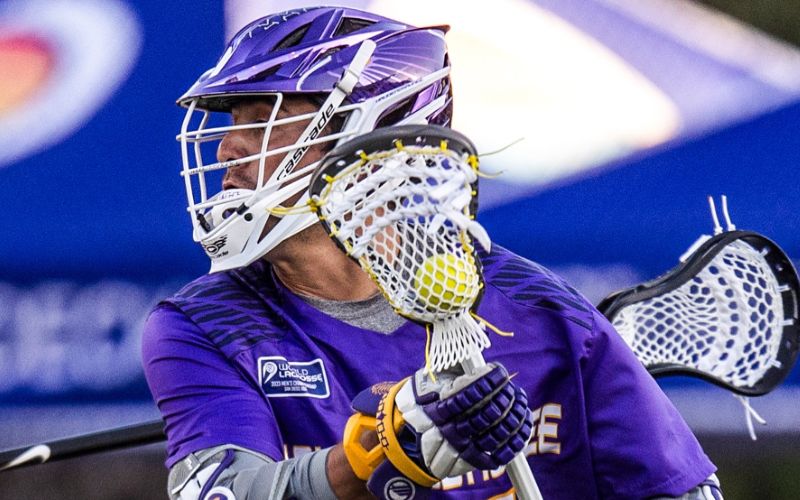
- Details
- By Jenna Kunze
At the White House Tribal Summit this month, President Joe Biden voiced his support for The Haudenosaunee National Lacrosse teams to compete in the upcoming 2028 Olympics under their own flag, in a show of support for tribal sovereignty.
In October, The International Olympic Committee voted to add lacrosse to the 2028 Olympic games in Los Angeles, California (LA28), for the first time in more than a century.
 Make A Donation Here
Make A Donation Here
The Haudenosaunee—a confederacy of six nations between the United States and Canada, including Mohawk, Oneida, Onondaga, Cayuga and Seneca, and Tuscarora—invented lacrosse and remain competitive at it on a world stage.
The Haudenosaunee Nationals men’s team ranks third in the world behind the United States and Canada in outdoor (and second indoor), and took home the bronze medal at the men's World Lacrosse Championships in June. The women’s team is ranked eighth globally and won gold at the Pan-American Lacrosse Association tournament in Jamaica in November.
“Their ancestors invented the game,” Biden said to a room full of Tribal delegates and members of Congress in Washington D.C. on Dec. 7. “They perfected it for a millennia. Their circumstances are unique, and they should be granted an exception to field their own team at the Olympics.”
Rex Lyons (Onondaga) is a former player for the then-Iroquois Nationals (the team changed its name in 2022 because Iroquois is a derogatory term the French called the Haudenosaunee) and a sitting board member for the Haudenosaunee Nationals Lacrosse Organization. He was on the inaugural team in 1983. Lyons told Native News Online that the Haudenosaunee are the “best ambassadors” for the sport of lacrosse.
“It's not like we don't belong there,” Lyons said. “And not only that, it’s our game. We are the originators. It’s a medicine game.”
For men and women Haudenosaunee lacrosse players, the ability to compete at the Olympics under their own flag would mean representation, liberation, and honor.
“For me personally, it would be a true honor,” said 31-year-old Mohawk player, Randy Staats. “It’s all the best words you could possibly think of, rolled up into one, to be able to put on that jersey and go side by side with all the other countries in the world. It’s not only representing my family and my people, but other Native people. It gives them hope and change for treaties that they have with their government.”
Casandra “Bean” Minerd (Onondaga), a 28-year-old member of the Haudenosaunee National women’s team, told Native News Online that competing as a sovereign nation in the Olympics would create an opportunity for global education. As an Indigenous woman, she said she’s used to debunking myths and defending her existence.
“Us going to the Olympics would be an opportunity for education, where we’re not going to be fighting as much to prove who we are…and that we’re not extinct,”Minerd said. “I know that when that time comes, and we're walking out with our flag and wearing our gear with Haudenosaunee across our chest, I'll be sobbing the whole time because it’s just so huge. It’s bigger than myself. We’re giving the opportunity to kids thinking they can work towards becoming an Olympic athlete.”
More Stories Like This
A Native American Heritage Month Playlist You Can Listen to All Year Long11 Native Actors You Should Know
Five Native American Films You Should Watch This Thanksgiving Weekend
Heavy metal is healing teens on the Blackfeet Nation
Over 150 Tribal Museums Participate in Fourth Annual Celebration of Native Life
Help us tell the stories that could save Native languages and food traditions
At a critical moment for Indian Country, Native News Online is embarking on our most ambitious reporting project yet: "Cultivating Culture," a three-year investigation into two forces shaping Native community survival—food sovereignty and language revitalization.
The devastating impact of COVID-19 accelerated the loss of Native elders and with them, irreplaceable cultural knowledge. Yet across tribal communities, innovative leaders are fighting back, reclaiming traditional food systems and breathing new life into Native languages. These aren't just cultural preservation efforts—they're powerful pathways to community health, healing, and resilience.
Our dedicated reporting team will spend three years documenting these stories through on-the-ground reporting in 18 tribal communities, producing over 200 in-depth stories, 18 podcast episodes, and multimedia content that amplifies Indigenous voices. We'll show policymakers, funders, and allies how cultural restoration directly impacts physical and mental wellness while celebrating successful models of sovereignty and self-determination.
This isn't corporate media parachuting into Indian Country for a quick story. This is sustained, relationship-based journalism by Native reporters who understand these communities. It's "Warrior Journalism"—fearless reporting that serves the 5.5 million readers who depend on us for news that mainstream media often ignores.
We need your help right now. While we've secured partial funding, we're still $450,000 short of our three-year budget. Our immediate goal is $25,000 this month to keep this critical work moving forward—funding reporter salaries, travel to remote communities, photography, and the deep reporting these stories deserve.
Every dollar directly supports Indigenous journalists telling Indigenous stories. Whether it's $5 or $50, your contribution ensures these vital narratives of resilience, innovation, and hope don't disappear into silence.
 The stakes couldn't be higher. Native languages are being lost at an alarming rate. Food insecurity plagues many tribal communities. But solutions are emerging, and these stories need to be told.
The stakes couldn't be higher. Native languages are being lost at an alarming rate. Food insecurity plagues many tribal communities. But solutions are emerging, and these stories need to be told.
Support independent Native journalism. Fund the stories that matter.
Levi Rickert (Potawatomi), Editor & Publisher

